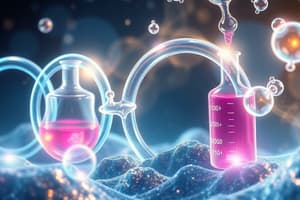Podcast
Questions and Answers
How is the name of alkynes derived from their corresponding alkanes?
How is the name of alkynes derived from their corresponding alkanes?
The name of alkanes is modified by changing the ending -ane to -yne.
What is the general formula for alkynes?
What is the general formula for alkynes?
The general formula for alkynes is C_nH_{2n-2}.
Describe the process to prepare ethyne using calcium dicarbide.
Describe the process to prepare ethyne using calcium dicarbide.
To prepare ethyne, calcium dicarbide is placed in a test tube, and water is added until it reacts completely, producing ethyne gas.
What observation would you make when ethyne is ignited?
What observation would you make when ethyne is ignited?
What happens when a few drops of bromine water are added to ethyne gas?
What happens when a few drops of bromine water are added to ethyne gas?
What type of forces primarily hold cyclohexane molecules together?
What type of forces primarily hold cyclohexane molecules together?
Identify the state of cyclohexane when there are 15 or more carbon atoms.
Identify the state of cyclohexane when there are 15 or more carbon atoms.
What is the IUPAC name for a compound with six carbons and a C=C double bond starting at carbon atom 2?
What is the IUPAC name for a compound with six carbons and a C=C double bond starting at carbon atom 2?
How would you describe the flame produced when ethene is ignited?
How would you describe the flame produced when ethene is ignited?
What observable change occurs when ethene reacts with limewater?
What observable change occurs when ethene reacts with limewater?
What happens to the color of bromine water when mixed with ethene?
What happens to the color of bromine water when mixed with ethene?
What is formed when potassium manganate(VII) is added to ethene?
What is formed when potassium manganate(VII) is added to ethene?
Characterize the solubility behavior of ethene.
Characterize the solubility behavior of ethene.
What characterizes a saturated compound?
What characterizes a saturated compound?
List the first four members of the alkane series and their states at room temperature.
List the first four members of the alkane series and their states at room temperature.
Why are alkanes insoluble in water?
Why are alkanes insoluble in water?
Define a homologous series in organic chemistry.
Define a homologous series in organic chemistry.
What are structural isomers?
What are structural isomers?
What makes carbon unique compared to other elements?
What makes carbon unique compared to other elements?
Name a common source of hydrocarbons.
Name a common source of hydrocarbons.
What are the two primary components of Liquefied Petroleum Gas (LPG)?
What are the two primary components of Liquefied Petroleum Gas (LPG)?
Why are mercaptans added to LPG?
Why are mercaptans added to LPG?
What is the primary use of kerosene?
What is the primary use of kerosene?
How does the length of the alkane chain affect the octane number?
How does the length of the alkane chain affect the octane number?
What is autoignition in the context of petrol engines?
What is autoignition in the context of petrol engines?
What was the purpose of adding lead to petrol in the past?
What was the purpose of adding lead to petrol in the past?
What kind of compounds generally have a higher octane number?
What kind of compounds generally have a higher octane number?
Name one use of naphtha in the petrochemical industry.
Name one use of naphtha in the petrochemical industry.
What is the primary characteristic of benzene that contributes to its stability?
What is the primary characteristic of benzene that contributes to its stability?
What observable change occurs when bromine water is mixed with an alkene?
What observable change occurs when bromine water is mixed with an alkene?
How does the process of fractional distillation separate crude oil?
How does the process of fractional distillation separate crude oil?
What type of flame does ethyne produce when burned, and what is the consequence of this combustion?
What type of flame does ethyne produce when burned, and what is the consequence of this combustion?
Define aromatic compounds and provide an example.
Define aromatic compounds and provide an example.
What happens to KMnO4 when it is used in reactions with unsaturated hydrocarbons?
What happens to KMnO4 when it is used in reactions with unsaturated hydrocarbons?
Why are refinery gases essential for a refinery?
Why are refinery gases essential for a refinery?
What distinguishes aliphatic compounds from aromatic compounds?
What distinguishes aliphatic compounds from aromatic compounds?
What is the initial temperature of the hydrochloric acid solution measured before mixing?
What is the initial temperature of the hydrochloric acid solution measured before mixing?
What should be done immediately after the sodium hydroxide is added to the hydrochloric acid solution?
What should be done immediately after the sodium hydroxide is added to the hydrochloric acid solution?
In the equation heat liberated = m c ∆T, what does each variable represent?
In the equation heat liberated = m c ∆T, what does each variable represent?
Why should the answer for the heat of reaction be given a negative sign?
Why should the answer for the heat of reaction be given a negative sign?
State Hess's Law in your own words.
State Hess's Law in your own words.
In calculating the heat of formation of methane, which reaction's enthalpy change is required?
In calculating the heat of formation of methane, which reaction's enthalpy change is required?
What is the heat of formation of water according to the provided data?
What is the heat of formation of water according to the provided data?
Why is it important to avoid splashing when mixing the acid and the base?
Why is it important to avoid splashing when mixing the acid and the base?
Flashcards
Hydrocarbon
Hydrocarbon
A compound containing only carbon and hydrogen atoms.
Fossil Fuel
Fossil Fuel
Fuel formed from ancient plant and animal remains.
Alkane
Alkane
A hydrocarbon with only single bonds between atoms; a saturated hydrocarbon.
Saturated Compound
Saturated Compound
Signup and view all the flashcards
Homologous Series
Homologous Series
Signup and view all the flashcards
Isomer
Isomer
Signup and view all the flashcards
Structural Isomer
Structural Isomer
Signup and view all the flashcards
General Formula of Alkanes
General Formula of Alkanes
Signup and view all the flashcards
Alkynes general formula
Alkynes general formula
Signup and view all the flashcards
Ethyne formula
Ethyne formula
Signup and view all the flashcards
Ethyne use
Ethyne use
Signup and view all the flashcards
Ethyne solubility
Ethyne solubility
Signup and view all the flashcards
Ethyne preparation method
Ethyne preparation method
Signup and view all the flashcards
Cyclohexane solubility in water
Cyclohexane solubility in water
Signup and view all the flashcards
Alkane boiling/melting points
Alkane boiling/melting points
Signup and view all the flashcards
5-methylhex-2-ene
5-methylhex-2-ene
Signup and view all the flashcards
Preparation of ethene
Preparation of ethene
Signup and view all the flashcards
Ethene properties: flame
Ethene properties: flame
Signup and view all the flashcards
Ethene properties: limewater
Ethene properties: limewater
Signup and view all the flashcards
Ethene properties: bromine
Ethene properties: bromine
Signup and view all the flashcards
Alkyne characteristic
Alkyne characteristic
Signup and view all the flashcards
Aromatic Hydrocarbons
Aromatic Hydrocarbons
Signup and view all the flashcards
Benzene
Benzene
Signup and view all the flashcards
Delocalized Electrons
Delocalized Electrons
Signup and view all the flashcards
Fractional Distillation
Fractional Distillation
Signup and view all the flashcards
Refinery Gases
Refinery Gases
Signup and view all the flashcards
Crude Oil
Crude Oil
Signup and view all the flashcards
Fractions
Fractions
Signup and view all the flashcards
Aliphatic Compound
Aliphatic Compound
Signup and view all the flashcards
Octane Number
Octane Number
Signup and view all the flashcards
Knocking
Knocking
Signup and view all the flashcards
2,2,4-trimethylpentane
2,2,4-trimethylpentane
Signup and view all the flashcards
Heptane
Heptane
Signup and view all the flashcards
LPG
LPG
Signup and view all the flashcards
Mercaptans
Mercaptans
Signup and view all the flashcards
Higher Octane Number
Higher Octane Number
Signup and view all the flashcards
Factors Affecting Octane Number
Factors Affecting Octane Number
Signup and view all the flashcards
Heat of Formation
Heat of Formation
Signup and view all the flashcards
Standard State
Standard State
Signup and view all the flashcards
Exothermic Reaction
Exothermic Reaction
Signup and view all the flashcards
Hess's Law
Hess's Law
Signup and view all the flashcards
Heat of Reaction
Heat of Reaction
Signup and view all the flashcards
Calculate Enthalpy Change
Calculate Enthalpy Change
Signup and view all the flashcards
What does ΔH represent?
What does ΔH represent?
Signup and view all the flashcards
What is the SI unit for ΔH?
What is the SI unit for ΔH?
Signup and view all the flashcards
Study Notes
Organic Chemistry
- Organic chemistry is the study of carbon compounds.
- Carbon forms stable rings and chains of its atoms.
- Most organic compounds are covalent compounds.
- Carbon has the ability to form covalent bonds with itself and other elements.
Hydrocarbons
- A hydrocarbon is a compound containing only carbon and hydrogen.
- Common sources are coal, natural gas, and petroleum.
- Fossil fuels are formed from the remains of plants and animals millions of years ago.
Alkanes
- Alkanes are hydrocarbons where all atoms are linked by single bonds.
- They are saturated compounds.
- Saturated compounds have only single bonds between atoms.
- Example alkanes: methane, ethane, propane, butane, pentane, hexane, heptane, octane, nonane, and decane.
- Each alkane and its molecular formula are listed in table.
Homologous Series
- A homologous series is a series of compounds with similar chemical properties that show gradations in physical properties.
- Each member differs from the previous member by a (CH2) unit.
Isomers
- Structural isomers are compounds with the same molecular formula but different structural formulas.
- Example of structural isomerism for butane is shown in the text(structural formulas).
Naming of Alkanes
- IUPAC rules are used for naming organic compounds.
- Side chains are called alkyl groups (e.g., methyl, ethyl).
- Prefixes like "di-" are used when two identical groups are present.
- Example of naming a compound with formulas and steps are shown in the text.
Alkenes
- Alkenes are hydrocarbons with one or more carbon-carbon double bonds.
- They are unsaturated compounds.
- General formula for alkenes is CnH2n.
- Example of alkenes: ethene (ethylene), propene, and butene(isomerism begins).
- Properties of alkenes (soluble in non-polar solvents, insoluble in water) are noted.
- Naming of alkenes (longest chain containing the C=C double bond, numbering the chain) are noted.
Alkynes
- Alkynes are hydrocarbons containing carbon-carbon triple bonds.
- They are highly unsaturated.
- General formula for alkynes is CnH2n-2.
- Example is ethyne (acetylene).
- Properties of alkynes (insoluble in water due to Van der Waals forces)are noted.
Aromatic Hydrocarbons
- Aromatic compounds contain a benzene ring structure.
- Benzene has a delocalized electron system.
- Aromatic compounds are often highly stable and not reactive.
- Example given is benzene.
Oil Refining
- Crude oil is a mixture of hydrocarbons, separated by fractional distillation.
- Fractional distillation separates crude oil into various fractions (different boiling points).
- Fractions have different uses, e.g., petrol, kerosene, diesel, etc.
- Octane number is a measure of a fuel's tendency to resist knocking.
- Catalytic cracking breaks down long-chain hydrocarbons into shorter ones.
Heat of Reaction
- Heat of reaction is the heat change when a specific number of moles of reactants react completely.
- ΔH (delta H) is used to indicate the heat change.
- Exothermic reactions release heat (+ΔH), and endothermic reactions absorb heat (- ΔH).
Heat of Combustion
- Heat of combustion is the heat change when one mole of a substance is completely burned in excess oxygen.
- Bomb calorimetry is used to measure heats of combustion.
Heat of Neutralization
- Heat of neutralization is the heat change when one mole of H+ ions from an acid reacts with one mole of OH- ions from a base
Other
- Hydrogen production methods (steam reforming and electrolysis) are mentioned.
Studying That Suits You
Use AI to generate personalized quizzes and flashcards to suit your learning preferences.




